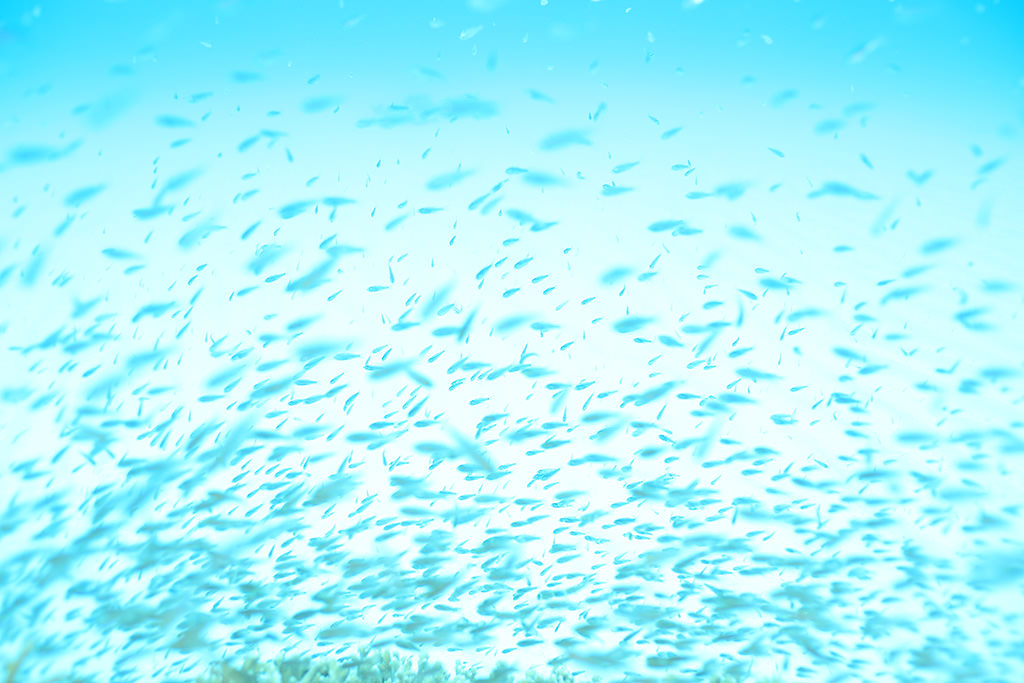4 Keys to Capturing Lovely Underwater Photos in Shades of Aquamarine
The way you light your shots underwater can change its colour tones. Here’s how one photographer made use of light to capture a lovely underwater shot where everything including the fish is tinged in lovely shades of aquamarine—no filter needed. (Report by: Yasuaki Kagii)

EOS 5D Mark III/ EF35mm f/1.4L USM/ FL: 35mm/ Manual exposure (f/2.5, 1/200 sec)/ ISO 100/ WB: Auto/ Picture Style: Landscape
I was awed by the school of blue-green fish swimming freely in the water, and wanted to accurately capture the feel of the scene. I took care to preserve the sense of movement in the shot. To get the colours, I selected a shallow sandy area where the water appeared pale blue due to the sunlight, and used the flash at low intensity.
Key 1: Lighting – Capture the fish with direct light
The light from a flash can only help you to capture some of the colours in the shot. To make sure that the colours that you see with the naked eye are reproduced as accurately as possible, make good use of direct light from the sun. Try to shoot in shallow water where the sunlight reaches.
Not enough direct light

EOS 5D Mark III/ EF17-40mm f/4L USM/ FL: 17mm/ Manual exposure (f/8.0, 1/40sec)/ ISO 400/ WB: Auto/ Picture Style: Landscape
The blue-green chromis is a light blue fish, but in the areas underwater where sunlight doesn’t reach, they do not appear blue.
Key 2: Shooting location – Sandy areas reflect light. Make use of them
Some underwater sandy areas reflect light so well that they make brighter shooting locations than land. Look for these and make use of them. They will help you to reproduce the blues in your shot beautifully.
Not the desired shade of blue

EOS 5D/ EF100mm f/2.8 Macro USM/ FL: 100mm/ Manual exposure (f/7.1, 1/13 sec)/ ISO 100/ WB: Daylight/ Picture Style: Landscape
In a rocky area, the water appears a deep blue. Here, I used a flash and a slower shutter speed which brightened the background, but it doesn't result in aquamarine tones. For a scene like that, you can use the same settings and pan the shot slightly to enhance the motion blur, which creates a different look. (Find out more here)
Key 3: Shooting functions – Use Picture Style to make colours appear more vivid
Set the Picture Style to “Landscape” when you want to render the blues of the sea in more vivid tones. This might be a brighter blue than what your eyes see, but it achieves this better contrast. The fish and coral also look more three-dimensional, and the fish stand out better in the water.
Picture Style - Standard

Picture Style - Landscape

Both shots: EOS 5D Mark III/ EF35mm f/1.4L USM/ FL: 35mm/ Manual exposure (f/2.5, 1/200 sec)/ ISO 100/ WB: Auto
Notice that the shot taken with Picture Style - Standard appears paler.
Key 4: Equipment - Use the flash to make your subjects appear even more three-dimensional
Large creatures such as whale sharks and dolphins can usually be photographed using only sunlight. However, in deeper water, this would make your photos will appear flat. To make subjects such as fish and coral look more three dimensional, use a flash. For the photo at the beginning of this article, I fired a flash using a lower intensity so that the colour was not lost.
Learn about what an external flash can do for you in:
What are the Benefits of an External Flash?
No flash: Too flat and indistinct

EOS 5D Mark III/ FL: 35mm/ Manual exposure (f/2.5, 1/160 sec)/ ISO 100/ WB: Auto/ Picture Style: Landscape
When shot without a flash, the fish look so flat that you can only vaguely see their shapes.
Here are some more techniques to try when shooting underwater:
Macro Lens Techniques: Liven Up Your Underwater Photos with Foreground Bokeh Dots!
4 Ways to Make Your Underwater Photos Pop with Colour
Here’s How You Can Achieve Black Backgrounds in Underwater Photography
Which technique did you like the most? Let us know how it worked for you: Share it with us on My Canon Story.
Receive the latest update on photography news, tips and tricks.
Be part of the SNAPSHOT Community.
Sign Up Now!About the Author
A monthly magazine that believes that enjoyment of photography will increase the more one learns about camera functions. It delivers news on the latest cameras and features and regularly introduces various photography techniques.
Published by Impress Corporation
Born 1971 in Hyogo Prefecture, Kagii is an underwater photographer, and was apprentice to the underwater photographer, Katsutoshi Ito, during his university days. He became a freelance photographer in 1998, and specializes in a photography style that lets him get close to the natural rhythm of living creatures so as not to stress them where possible.
Kagii has been a representative of Clé et Photos since 2013.

































